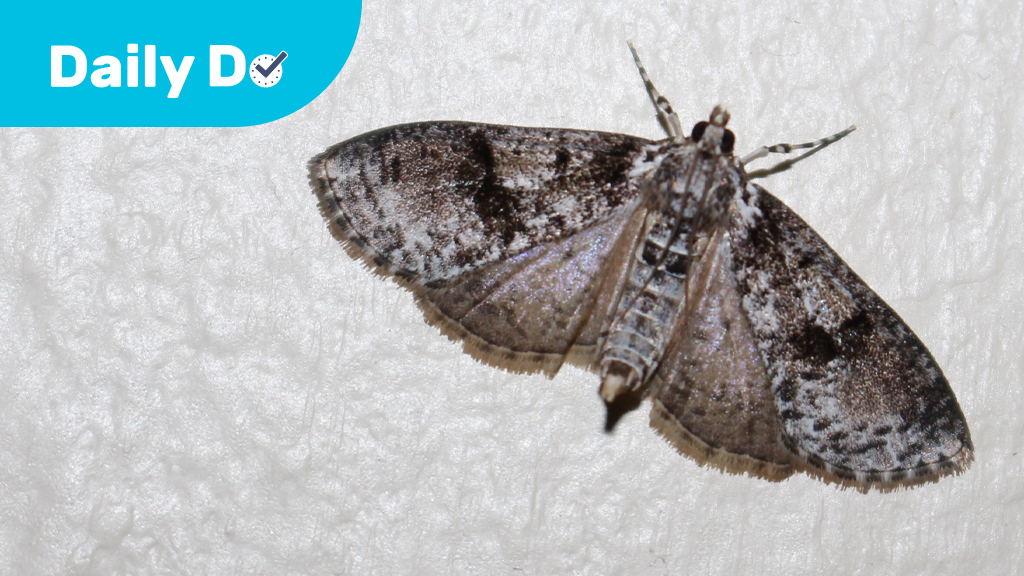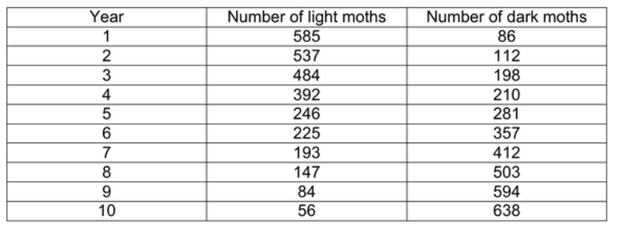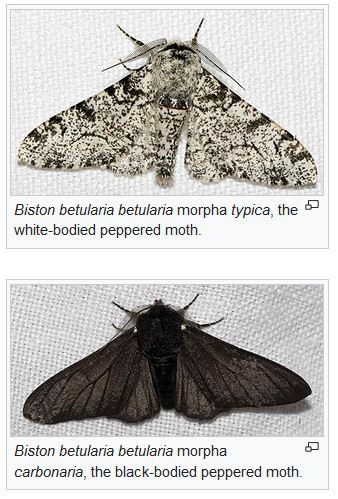High School | Daily Do
How Did The Moth Population Change?

Biology Crosscutting Concepts Disciplinary Core Ideas Is Lesson Plan Life Science NGSS Phenomena Science and Engineering Practices Three-Dimensional Learning High School Grades 9-12
Introduction
Today's task, How did the moth population change?, creates an opportunity for students to look at examples of how different factors affect shifts in organisms population. Students engage in science and engineering practices - including the use graphical data - to figure out why some populations may shifts over time.
This task has been designed in order to be used by students, parents, and teachers in distance and home learning. While older students could complete this task independently, we encourage younger students to work virtually with peers or in the home with family members.
Presentation of Phenomena (What am I exploring today?)
Documenting populations are done for many reasons. State agencies, environmentalists, and many others keep track of populations of both plants and animals to ensure that the ecosystems within an area stay healthy. When a dramatic shift happens in a population it often raises questions about what is going on. For today's Daily Do we will explore the shift in a population of moths to try to figure out what is going on in the ecosystem to cause such a dramatic shift in population.
Guidance: Students-as-scientists take on the role of biologist. The goal is to get students thinking about patterns they are seeing in the data to generate investigative questions about the dramatic shift in population. Presenting a phenomenon and asking students to generate questions about it creates a need to figure out the answer to those questions. This is authentic engagement and a powerful learning process (unlike "learning about" populations and ecosystems).
Experiencing the Phenomenon:
Have students analyze the data below. Ask students to record what they notice about the population. Our goal here is to promote student thinking around the science practice of analyzing and interpreting data. Next, ask students what patterns they notice in the data and have them record any questions they have about the moth data. ALL student questions are okay at this point. Our goal is to motivate curiosity and not distinguish between "good questions" and "bad questions" or "right questions" and "wrong questions". Common questions will arise for most students, which is what this task builds on.

Investigative Questions (What questions do I have about what I just saw?)
Investigative questions are common questions kids may ask after they are introduced to the phenomena. Although questions may vary, many students are curious about what is going on with the moth population and why it shifted so dramatically.
Guidance: It is important to allow time for thinking. Many students have ideas and questions but need time to formulate their idea or question into words. Some students may also benefit from writing things down first before they share. As adults we may be tempted to give them questions we feel might be important to explore, however, we need to refrain from this and allow our students to practice asking their own questions. Our goal here is for students to consider all of the different factors that may have noticed before but never really thought about.
Common Questions:
- What happened to the light-colored moths?
- Did the light-colored moths get a disease?
- Did the dark-colored moths start having more babies?
- Do the moths live in the same place?
- Will the moth populations shift back?
- Are the moths different colors of the same species?
- Do the moths eat the same things?
Students may make connections to previous concepts depending on their grade level. For example, elementary students may mention that moths come from a caterpillar so maybe something is happening to the caterpillars. Middle school students may know that there are different interactions that can happen within an ecosystem that can cause a shift in the population of an organism. Other things students may mention are there are things that eat both caterpillars and moths, there are chemicals that people use to kill insects, and that there are several things that all animals need to survive.
Student Ideas and Background Knowledge
Based on our initial questions, we think we need to figure out some things about these light- and dark-colored moths. Why is there a difference in their appearance? First, here are some basic things we need to know about them:
- Dark-colored moths were considered rare since they were not seen as often as light-colored moths.
- The moths we are studying are called peppered moths.
- The moths are different colors of the same species.
- The moths live in the same area, in this case England (late 1800s to early 1900s)
Guidance: The information (bulleted items) above can be shared with the students or students could do some basic research about peppered moth. You might also share this article, Peppered Moths, with students.
Brainstorming Ideas
Guidance: Brainstorming is a great way to get students thinking and collaborating. If you are doing this at home, try a brainstorming discussion to get ideas out. If you are doing this with a group of students have them brainstorm independently first then share their ideas with a partner or small group.
Ask students to brainstorm ideas about what they think might be happening that would cause a shift in color within the moth population. Common ideas include:
- White moths are getting a disease and dying.
- There is not enough food.
- Something is eating the white moths.
Prompt students to think about the population of moths as a whole, using questions such as:
- If the moths are the same species do we think a disease would only affect the light-colored ones?
- If both light- and dark-colored moths live in the same area would a food shortage only affect some members of the same population?
- What idea would be the easiest to investigate?
Ask students which idea we should investigate. Students will likely say we should figure out if something is eating the light-colored moths.

Conducting an Investigation
Tell student that birds eat moths so to help us figure out what is going with the moth population you are going to gather some data. Have students engaged in the Peppered Moth Simulation in order to gather some data on light moth and dark moth populations.
After each game have students record the summary percents of light moths and dark moths which appear in a black text box when the game is complete. Ask students to create a data table or t-chart to keep their data organized.
Have students play at least 2 rounds in each of the colored forests (more rounds are better if there is time). If you are doing this as a class, consider having students share their data as part of a class data chart.
After the data has been collected, have students identify any patterns they notice. They should notice that dark moths on light trees get eaten at a higher percent than light moths on light trees and vice versa.
Taking Stock
After looking at the patterns in the data, engage students in a "taking stock" discussion. Ask students what they know about the moths so far that would help them figure out the lesson question.
- Both light- and dark-colored moths live in the same area.
- Both light- and dark-colored moths are eaten by birds.
- The moths are different colors of the same species.
- Some moths seem to blend into the environment better than others.
Have students discuss their ideas about why the population is shifting. Students will most likely say that the population is shifting because birds are eating the light-colored moths instead of the dark-colored ones.
Next, ask them why? Why would birds all of a sudden switch? Ask students what else could be going on in the ecosystem to cause this shift? Have students share their ideas.
After students share their ideas, have them read Natural Selection, which provides more information about the moths and where they lived.
Making Sense - What did we figure out?
Have a discussion around the question, What did we figure out from the reading, and how does it help up explain the data we analyzed at the beginning of the lesson?
During the discussion, students should demonstrate they have figured out:
- Both moths were represented in the population but we think the dark ones were getting eaten at a higher rate.
- When the environment changed, due to pollution, the moth population shifted because light-colored moths became easier to see so they were eaten more often.
- Organisms that survive have a better chance of reproducing so the population continues to grow.
- Human actions affect other populations
Last, have students think about how human activities continue to change environments. Ask students to think about how human actions affect populations of plants and/or animals in the area where you live.
Some organisms students can research include:
- Monarch Butterflies
- Asian Carp
- Big Horned Sheep
- Milkweed Plants
- Elodea
- Zebra Mussels
- Oysters


